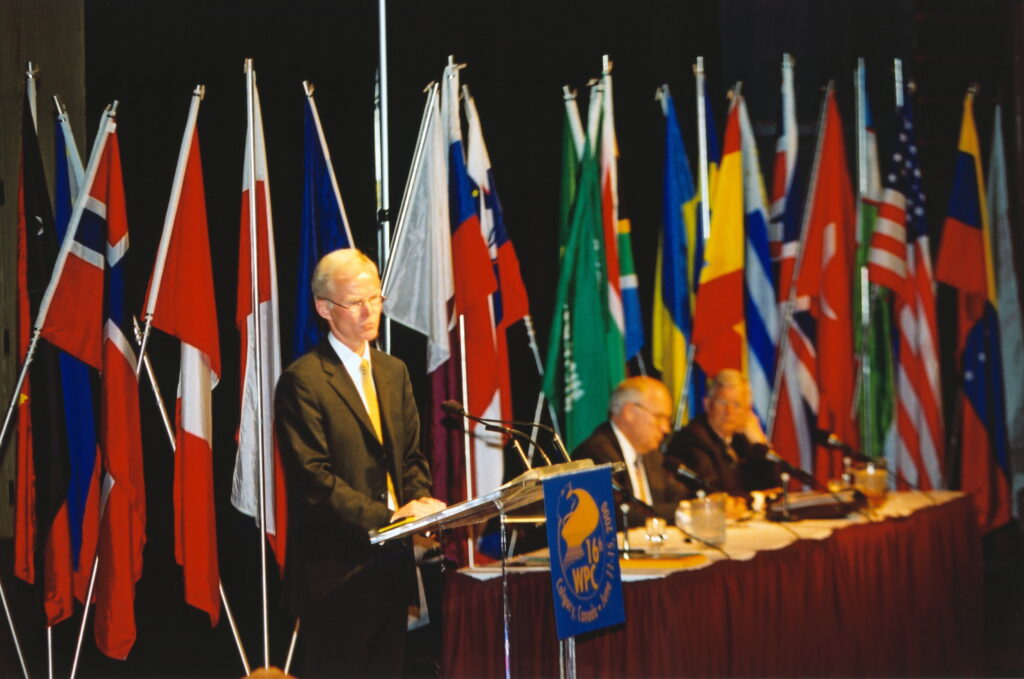International growth strategy under Olav Fjell

Statoil’s growth strategy during the Fjell years was formulated at a time of persistently low oil prices.[REMOVE]Fotnote: This article builds to a great extent on Boon, Marten, 2022, En nasjonal kjempe. Statoil og Equinor etter 2001. Universitetsforlaget: chapters 1 and 2. That contributed to its target of operating as cost-effectively as possible, and to favouring commitments which yielded revenues in the short term.[REMOVE]Fotnote: Boon 2022: 57. The priority on the Norwegian continental shelf (NCS) was therefore to limit resource devoted to exploration while seeking to increase production – and thereby income – from fields already on stream.
International commitments were intended to reduce the gap with the biggest oil majors.[REMOVE]Fotnote: However, the financial outcome of the partial privatisation had put a stop to the Statoil management’s desire to acquire a large part of the state’s direct financial interest (SDFI) which had been in the government’s hand since the company had its wings clipped in the 1980s. That reduced opportunities for rapid growth outside Norway. Boon, Marten, op.cit: 50-51. This strategy was less subject to the demands for short-term profits experienced on the NCS. Nevertheless, clear guidelines existed for how internationalisation should contribute to the company’s growth.
Organic expansion
During Fjell’s time, attention was concentrated on international growth occurring organically by building brick by brick.[REMOVE]Fotnote: Boon, op.cit: 58. On the general emphasis given to organic growth in this period, see Statoil annual reports for 2001: 58; 2002: 11 and 75, and 2003: 63. (References to annual reports in this text refer to the Norwegian edition of the reports.) This meant that Statoil would be involved in everything from exploration and development to production, which in turn made big demands on expertise in the organisation. Moreover, building up the business gradually – or organically – was time-consuming. Statoil’s advantage in this context was that its organisation had acquired solid experience from the NCS by following the whole course from small start to full production.
The alternative to organic growth is non-organic expansion, which means a company acquiring production capacity, for example, through mergers or acquisitions. That offers a quicker approach but makes bigger demands on the scale of the investment, since the company buys itself out of earlier phases such as exploration and development.[REMOVE]Fotnote: Ibid: 58.
NOC-NOC
A significant aspect of Statoil’s foreign commitment at this time was its concentration on certain geographical regions. An approach followed under Fjell – and which Statoil also had prior experience with – was to become involved in countries which, like Norway, had a national oil company (NOC). This was known as the NOC-NOC strategy.[REMOVE]Fotnote:Ibid, chapter 2 for more details. Such enterprises were found in places like Algeria, Azerbaijan, Venezuela and Iran, all nations where Statoil was engaged to varying degrees.

The starting point for such collaboration was that the company secured access to reserves/production in the country concerned. In return, it could serve as an adviser for that nation’s own NOC in such areas as technology and resource management.[REMOVE]Fotnote: Ibid: 68.
However, one place where Statoil’s international engagement eventually gave rise to substantial complications for the company was Iran. The “Horton affair” showed that this type of country could not only be challenging, but also cost the CEO his job.
For almost a year after Olav Fjell’s departure in September 2003, Statoil was left without a permanent CEO in place before Helge Lund took over in August 2004.
Changed perception
Lund’s arrival brought a changed perception of the opportunities offered by the partial privatisation. The first factor promoting this shift was rising oil prices. Second, internal disquiet was being voiced in the company about the meagre results achieved in exploring for new reserves abroad. A third was the new CEO himself.
With this change, the way was open for an adjustment of the strategy to give greater emphasis to non-organic growth.
arrow_backThe road to the stock marketGassco – background, creation and functionarrow_forward